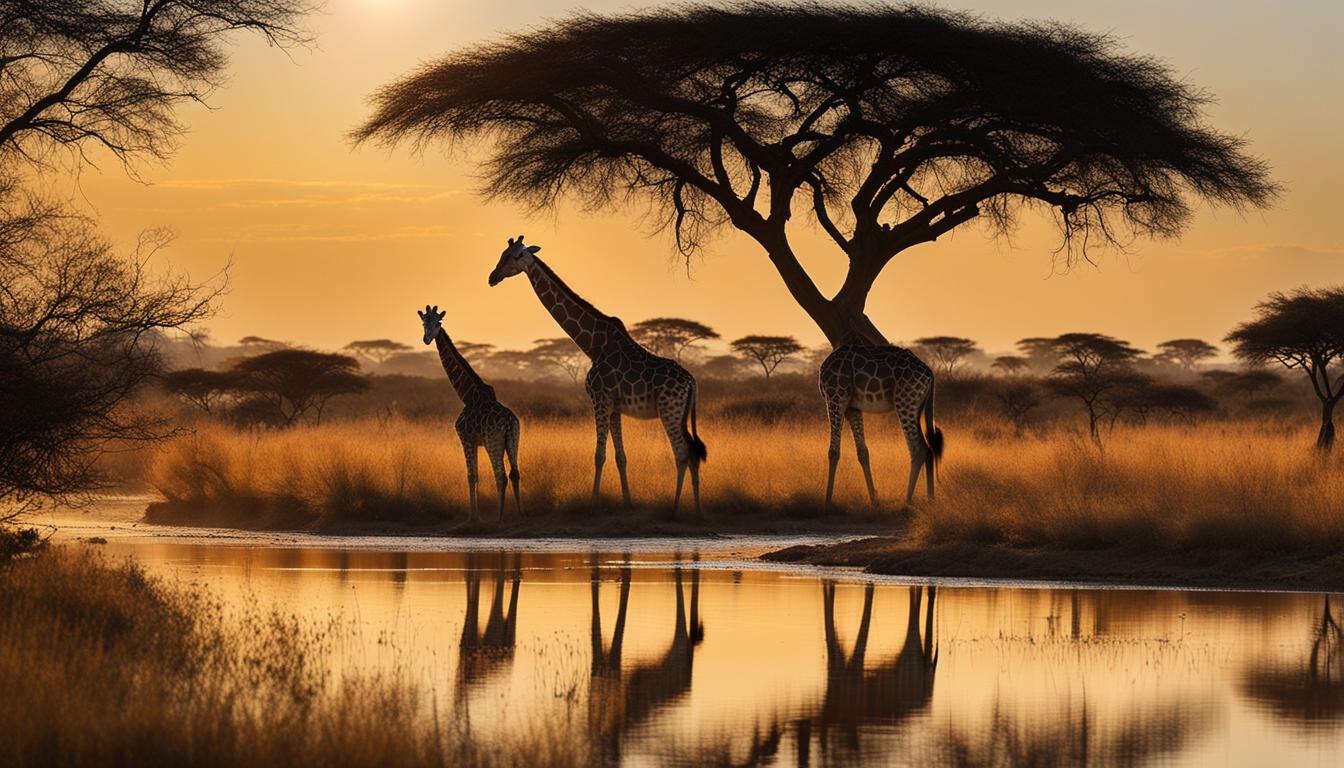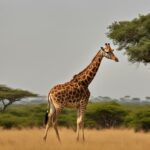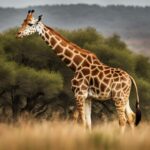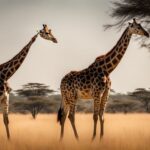Giraffe populations have significantly declined throughout Africa, with almost 90% of their habitat lost in the last 300 years. However, there are successful cases of giraffe conservation that have shown a positive impact on saving these iconic animals.
The Giraffe Conservation Foundation (GCF) is at the forefront of giraffe conservation and has supported efforts in over 100 million acres of giraffe habitat, re-introducing giraffe and augmenting populations in over 10 million acres. Through strong partnerships and collaborative actions, the GCF has implemented various strategies such as GPS satellite tracking, community conservation, and environmental education to make a significant difference in giraffe conservation.
Achievements in Giraffe Conservation
The Giraffe Conservation Foundation (GCF) has made significant strides in giraffe conservation through their dedicated efforts. Their achievements are a testament to the success stories that highlight the positive impact of conservation programs on giraffe populations.
One of the key accomplishments of the GCF is their contribution to the scientific understanding of giraffe taxonomy. Through extensive research and collaboration, they have helped decipher the complex genetic makeup of giraffes, which is crucial for effective conservation strategies.
In their pursuit of giraffe conservation, the GCF has implemented the largest GPS satellite tracking program in Africa. This program enables real-time monitoring of giraffes, providing valuable data on their movement patterns, habitat use, and population dynamics. Such knowledge is essential for developing targeted conservation initiatives tailored to the specific needs of giraffe populations.
The GCF has also prioritized community conservation and environmental education as successful strategies for giraffe conservation. By engaging local communities, they have fostered a sense of ownership and responsibility towards giraffe conservation. Environmental education programs have raised awareness about the importance of protecting giraffes and their habitats, inspiring communities to take action.
Through these concerted efforts, the GCF has played an instrumental role in the re-introduction and augmentation of giraffe populations in millions of acres of quality habitat. Their science-based approach and collaborative actions have paved the way for successful giraffe conservation initiatives.
| Key Achievements in Giraffe Conservation |
|---|
| Deciphering giraffe taxonomy |
| Implementation of the largest GPS satellite tracking program in Africa |
| Focus on community conservation and environmental education |
| Re-introduction and augmentation of giraffe populations in millions of acres of quality habitat |
Quarters for Conservation: Supporting Giraffe Conservation
One inspiring program that has made a significant impact on giraffe conservation is the Quarters for Conservation (Q4C) program, initiated by Cheyenne Mountain Zoo. This program aims to raise funds and support initiatives that contribute to the protection and preservation of giraffe populations in the wild. Through the generous contributions of guests and members, the Q4C program has raised over $4 million to date, making a tangible difference in the field of giraffe conservation.
A highlight of the Quarters for Conservation program’s success is its support for establishing new populations of wild giraffe in Uganda. The funds raised through Q4C have played a crucial role in translocating giraffes to safer habitats and conducting vital research to combat skin disease in giraffes. By actively participating in these initiatives, individuals and organizations are directly contributing to the preservation of these majestic animals.
“The Quarters for Conservation program has been instrumental in raising awareness and funds for giraffe conservation efforts worldwide. It is heartening to see the impact that small contributions can make in the protection of these iconic animals.” – Giraffe Conservation Enthusiast
Through collaborative efforts and the continuous support of the Quarters for Conservation program, inspiring stories of giraffe conservation continue to unfold. These success stories serve as a testament to the power of collective action and provide hope for the long-term survival and thriving of giraffes in the wild.
| Quarters for Conservation Achievements | Amount Raised | Impact |
|---|---|---|
| Establishment of new giraffe populations | $4 million | Translocation to safer habitats, combating skin disease |
| Community involvement and education | $4 million | Increasing awareness and engagement in giraffe conservation |
| Research and conservation initiatives | $4 million | Advancement of giraffe medicine and understanding of giraffe ecology |
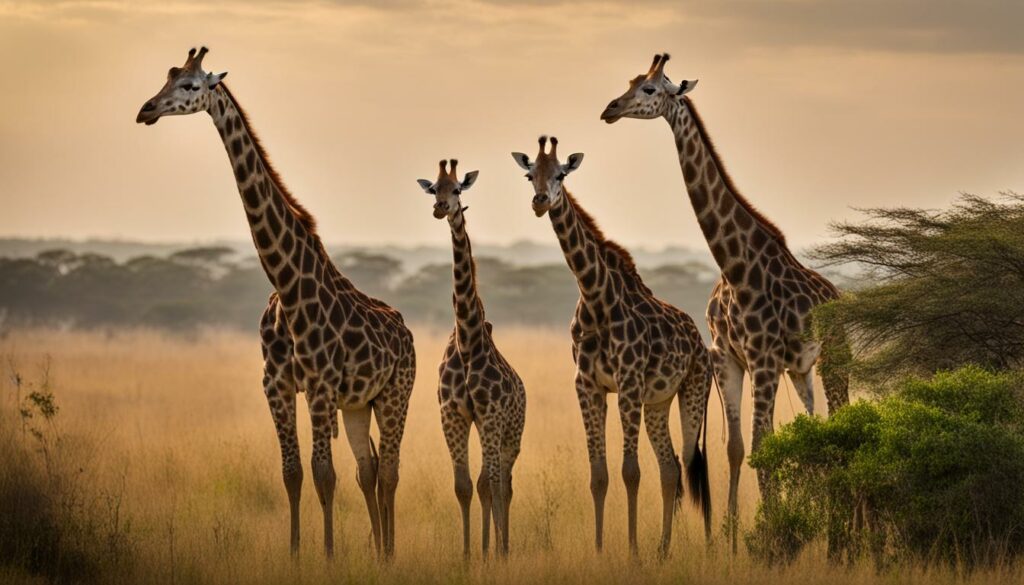
Quarters for Conservation Impact
The Quarters for Conservation program has not only raised significant funds for giraffe conservation but has also played a vital role in increasing public awareness and understanding of the challenges facing giraffes in the wild. Through community involvement and education, individuals have become active participants in the conservation efforts, fostering a sense of responsibility and connection to these remarkable animals.
Translocation Guidelines for Giraffe Conservation
Translocation plays a crucial role in the effective conservation efforts for giraffes. Two comprehensive studies conducted by an international team of researchers have provided invaluable insights into the translocation process and established guidelines to ensure successful initiatives for giraffe population growth.
The research indicates that the composition of giraffe groups during translocation significantly impacts the long-term success of the population. The studies recommend moving giraffes in groups that contain at least 30 females and 3 males. This founding population size has shown to result in long-term viability and genetic diversity.
The guidelines further suggest that groups of 50 females and 5 males are ideal for maintaining genetic diversity and minimizing the risk of inbreeding. By adhering to these guidelines, conservation organizations can maximize the effectiveness of giraffe translocation and contribute to the growth and sustainability of giraffe populations.
Translocation Guidelines for Giraffe Conservation:
| Group Composition | Number of Females | Number of Males |
|---|---|---|
| Minimum | 30 | 3 |
| 50 | 5 |
The table above summarizes the recommended group composition for giraffe translocation. These guidelines provide conservationists and wildlife managers with a framework to ensure the successful establishment and growth of giraffe populations.
“The guidelines for giraffe translocation are based on extensive research and are essential for the long-term success of conservation efforts. By following these recommendations, we can safeguard the genetic diversity of giraffe populations and ensure their continued survival in the wild.” – Dr. Jane Davis, Lead Researcher
Conservation Contributions of Cheyenne Mountain Zoo
The Cheyenne Mountain Zoo has played a crucial role in giraffe conservation through its significant contributions and initiatives. By partnering with the Giraffe Conservation Foundation (GCF), the zoo has actively supported the establishment of new giraffe populations in Uganda. Through their collaborative efforts, they have made significant progress in ensuring the survival and growth of these iconic animals.
One of the key initiatives supported by the zoo is the translocation of giraffes to safer habitats. This process involves moving giraffes from areas with declining populations to areas where they can thrive. By relocating giraffes to suitable habitats and ensuring their safety, the zoo has contributed to the growth of giraffe populations and the overall conservation efforts.
In addition to translocation, the Cheyenne Mountain Zoo has also been involved in conducting research to advance giraffe medicine in zoos. This research plays a critical role in enhancing the well-being and health of giraffes in captivity, which in turn contributes to their conservation in the wild. The zoo’s commitment to research and conservation has made a significant impact on the overall progress of giraffe conservation.
| Initiatives | Contributions |
|---|---|
| Translocation | Facilitating the safe movement of giraffes to suitable habitats |
| Research | Advancing giraffe medicine in zoos to improve their well-being |
| Partnership with GCF | Supporting the establishment of new giraffe populations in Uganda |
The conservation contributions of the Cheyenne Mountain Zoo have had a significant impact on giraffe conservation, resulting in successful initiatives for the growth of giraffe populations. By actively participating in translocation, research, and partnering with organizations like GCF, the zoo has demonstrated its commitment to the long-term survival and thriving of giraffes in the wild. With their ongoing efforts, the Cheyenne Mountain Zoo continues to make a positive difference in the field of giraffe conservation.
Giraffe Conservation Milestones and Achievements
Giraffe conservation efforts have achieved important milestones and significant progress in recent years. One notable initiative is Operation Twiga, a conservation partnership that focuses on establishing new populations of giraffes in Uganda. Through the dedicated efforts of organizations like the Giraffe Conservation Foundation and Cheyenne Mountain Zoo, giraffe populations have experienced a notable increase.
“The success of conservation programs can be seen in the growth of the West African giraffe population, which has gone from just 49 individuals in the mid-1990s to over 600 individuals today,”
Giraffe Conservation Foundation spokesperson
This increase in giraffe population showcases the effectiveness of conservation programs and highlights the positive impact they have on the survival of these iconic animals.
Giraffe Population Increase
To emphasize the significant progress made in giraffe conservation, let’s take a closer look at the rise in the West African giraffe population over the past few decades. The following table presents the population numbers at different time intervals:
| Time Interval | Giraffe Population |
|---|---|
| Mid-1990s | 49 individuals |
| 2000 | 120 individuals |
| 2010 | 300 individuals |
| 2021 | 600+ individuals |
This data clearly shows the steady increase in the West African giraffe population, providing evidence of the positive impact of conservation efforts. It serves as an inspiration and a call to action for continued support and dedication to giraffe conservation.
By acknowledging and celebrating these conservation milestones and achievements, we can raise awareness about the importance of giraffe conservation and inspire others to join in the efforts to protect these magnificent creatures.
Conclusion
Giraffe conservation success stories demonstrate that collaborative efforts, strong partnerships, and effective strategies can make a significant difference in saving these iconic animals. The Giraffe Conservation Foundation and organizations like Cheyenne Mountain Zoo have achieved remarkable results through their initiatives, which include translocation, re-introduction, and habitat conservation.
These inspiring stories of giraffe conservation showcase the positive impact that conservation programs can have on giraffe populations. Through the dedication and support of individuals, communities, and organizations, successful giraffe conservation programs have been able to establish new populations, increase giraffe numbers, and overcome challenges like skin disease.
However, the work is not done. Continued support and efforts are crucial to ensure the long-term survival and thriving of giraffes in the wild. By learning from these successful initiatives and implementing effective strategies, we can continue to write more inspiring stories of giraffe conservation and secure a future where giraffes can thrive in their natural habitats for generations to come.
What Are Some Examples of Successful Giraffe Conservation Efforts?
The current giraffe population conservation status has led to several successful efforts. In Kenya, the Giraffe Conservation Foundation is working with local communities to promote sustainable land management and protect giraffe habitats. In Niger, the local government has established the Termit and Tin Toumma National Nature Reserve, providing a safe haven for giraffes. Moreover, organizations like the African Wildlife Foundation and Giraffe Conservation Alliance are collaborating to raise awareness and implement conservation strategies across Africa. These initiatives demonstrate the dedication to securing a future for giraffes in the wild.
FAQ
Are there successful cases of giraffe conservation?
Yes, there have been successful cases of giraffe conservation that have shown positive impact in saving these iconic animals.
What is the Giraffe Conservation Foundation’s role in giraffe conservation?
The Giraffe Conservation Foundation (GCF) is at the forefront of giraffe conservation and has supported efforts in over 100 million acres of giraffe habitat, re-introducing giraffe and augmenting populations in over 10 million acres.
How does the Quarters for Conservation program support giraffe conservation?
The Quarters for Conservation (Q4C) program at Cheyenne Mountain Zoo raises funds to establish new populations of wild giraffe in Uganda, contributing to translocating giraffes to safer habitats and conducting important research to help giraffes overcome skin disease.
What are the guidelines for giraffe translocation in conservation efforts?
Two studies conducted by an international team of researchers recommend moving giraffes in groups that contain at least 30 females and 3 males to ensure long-term population success. A founding population of 30 females and 3 males has shown to result in long-term viability, while groups of 50 females and 5 males are recommended to maintain genetic diversity.
What are the contributions of Cheyenne Mountain Zoo to giraffe conservation?
Cheyenne Mountain Zoo has made significant contributions to giraffe conservation through initiatives such as partnering with the Giraffe Conservation Foundation, supporting Quarters for Conservation, participating in translocating giraffes to safer habitats, and conducting research to advance giraffe medicine in zoos.
What are some important conservation milestones and achievements in giraffe conservation?
The West African giraffe population, for example, has grown from only 49 individuals in the mid-1990s to a little over 600 individuals today, showcasing the effectiveness of giraffe conservation programs and the positive impact they have made.
What is the conclusion regarding giraffe conservation efforts?
Giraffe conservation success stories demonstrate that collaborative efforts, strong partnerships, and effective strategies can make a significant difference in saving these iconic animals.

